Indianz.Com >
News > Cronkite News: Border barriers continue to harm O’odham land
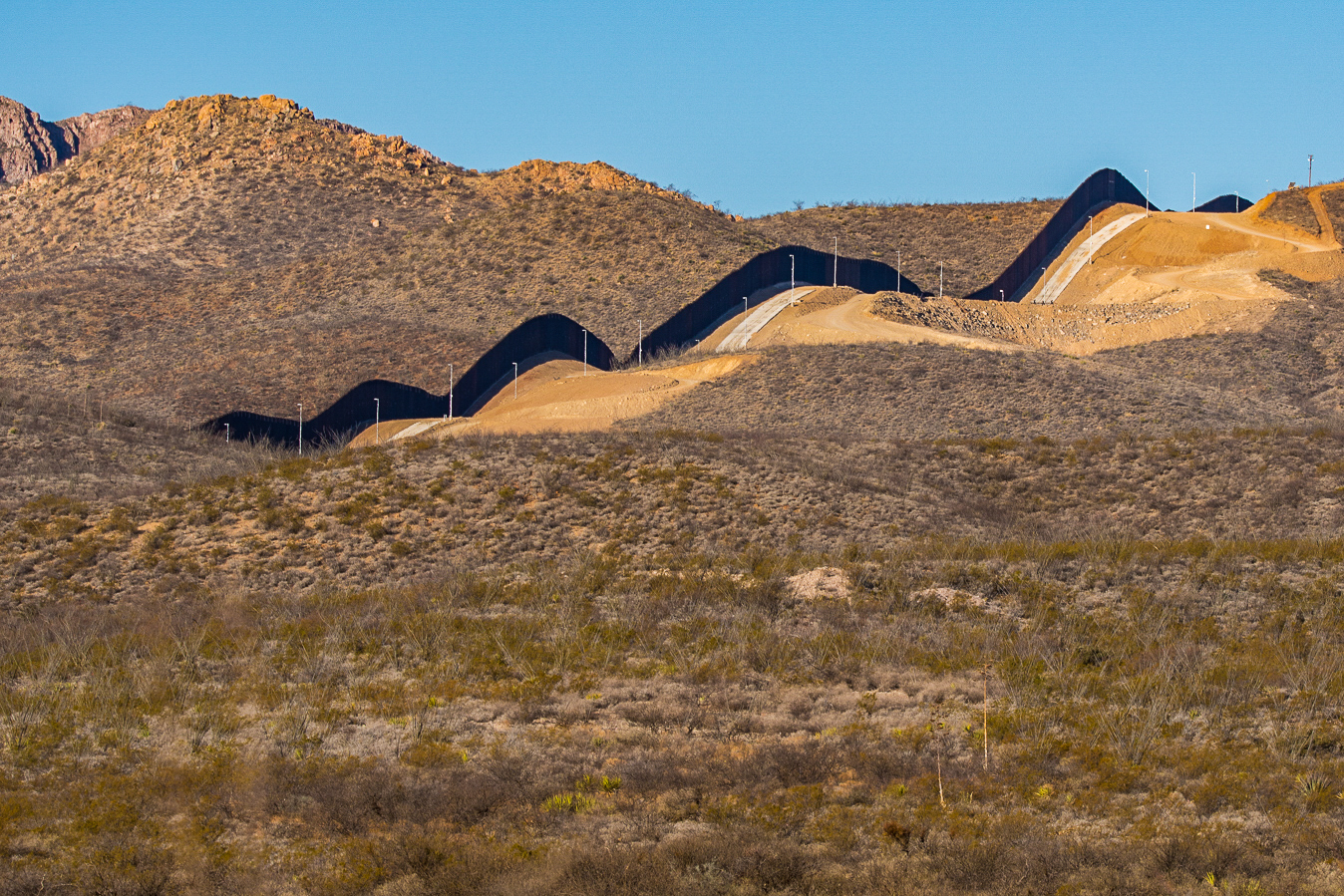 SAN BERNARDINO NATIONAL WILDLIFE REFUGE, ARIZONA – The Trump Administration constructed more than 200 miles of border barrier in Arizona, updating old barriers and creating about 55 miles of new barrier. MARCH 13, 2021 (Photo by Isaac Stone Simonelli/Cronkite Borderlands Project)
SAN BERNARDINO NATIONAL WILDLIFE REFUGE, ARIZONA – The Trump Administration constructed more than 200 miles of border barrier in Arizona, updating old barriers and creating about 55 miles of new barrier. MARCH 13, 2021 (Photo by Isaac Stone Simonelli/Cronkite Borderlands Project)
Unfinished border barriers harm environment, National Park Service, Arizona rancher say
Tuesday, June 8, 2021
Cronkite News
ORGAN PIPE CACTUS NATIONAL MONUMENT – Replanted saguaros stand like sentinels along a wide access road and a towering, 30-foot bollard barrier that’s part of construction ordered by then-President Donald Trump. But further along the border, the new barrier ends, the road is incomplete, construction materials lay scattered and uprooted plants have long since died.
Locals, security experts and environmentalists say the half-finished project has introduced more problems than it fixed.
Now, the administration of President Joe Biden – which paused wall construction in January – faces a logistical, ethical and political quandary in determining the best way to proceed. Some groups and interests want the wall finished, others want to remove what has already been built.
Kelly Glenn-Kimbro, a fifth-generation rancher from Douglas, and Rijk Morawe of the National Park Service come from vastly different backgrounds and work along the border in different regions of Arizona. But both say the wall – as it stands – is little more than a political prop that has failed to secure the border with Mexico but has damaged landscapes and habitat in southern Arizona.
Kelly Glenn-Kimbro, whose family has ranched in southeastern Arizona for five generations, says border security is vital but the wall as it stands is a mess. (Photo courtesy of Kelly Glenn-Kimbro)
For them, the solution is to mitigate the damage caused during the building process by finishing access roads, completing flood control infrastructure and repairing as much environmental damage as possible.
“They got the fence built, right?” said Morawe, the chief of natural and cultural resources management at Organ Pipe Cactus National Monument, which runs 30 miles along the border. “Now they need to finish the project so that they don’t leave issues going forward.”
Glenn-Kimbro, who first caught the national spotlight in the 1980s when firearms manufacturer Ruger asked her to star in advertisements as the Ruger Girl, has been an advocate for border security for 45 years.
But the wall, for which $15 billion was allocated during Trump’s tenure, is a waste of taxpayers’ money, she said, because it doesn’t stop illegal border crossings. Glenn-Kimbro feels this way even though her ranch, which abuts Mexico, benefited financially from the construction.
“Instead of doing it right, they were just going to do it,” she said. “So instead of ending up with something very effective, they end up with something that’s a total disaster.”
In areas where barrier construction has been finished, there have been multiple reports of migrants scaling the wall with homemade ladders.
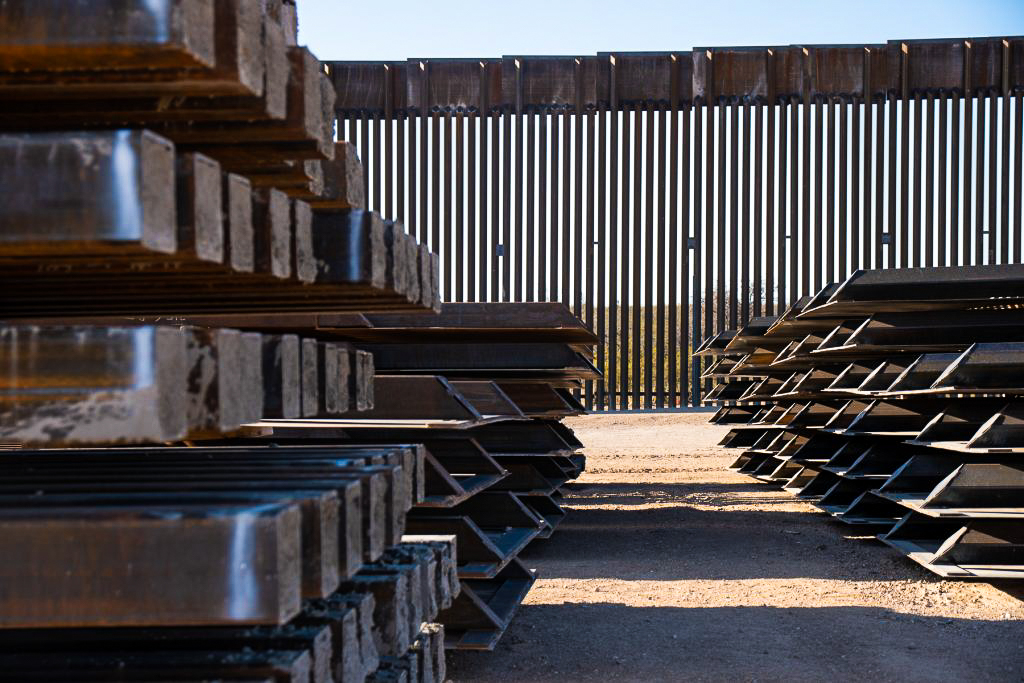 Steel bollards are stacked at a border barrier construction-staging site. President Joe Biden halted border wall construction on his first day in office. (Photo by Isaac Stone Simonelli/Cronkite Borderlands Project)
Steel bollards are stacked at a border barrier construction-staging site. President Joe Biden halted border wall construction on his first day in office. (Photo by Isaac Stone Simonelli/Cronkite Borderlands Project)
Making good on a campaign promise, Biden “paused”
border wall construction in an executive order on his first day in office. The order demanded top officials in relevant departments, including Defense and Homeland Security, to present a plan by March 26 to redirect funds and repurpose contracts originally drawn up to build the wall.
That deadline passed without a resolution, leaving construction and staging sites along the wall abandoned with building materials baking in the sun, sections of constructed wall flat on the ground and various tasks undone, including the completion of floodgates, road grading, and measures to prevent flooding.
That’s in contrast to some locations where new 30-foot-tall steel bollard barrier towers over the Arizona landscape. The concrete-filled bollards are 6 inches wide, with 4-inch gaps between them.
On April 30, the Department of Homeland Security announced it would work to complete some parts of the border barrier project to prevent flooding and erosion, but the length of the barrier would not be extended.
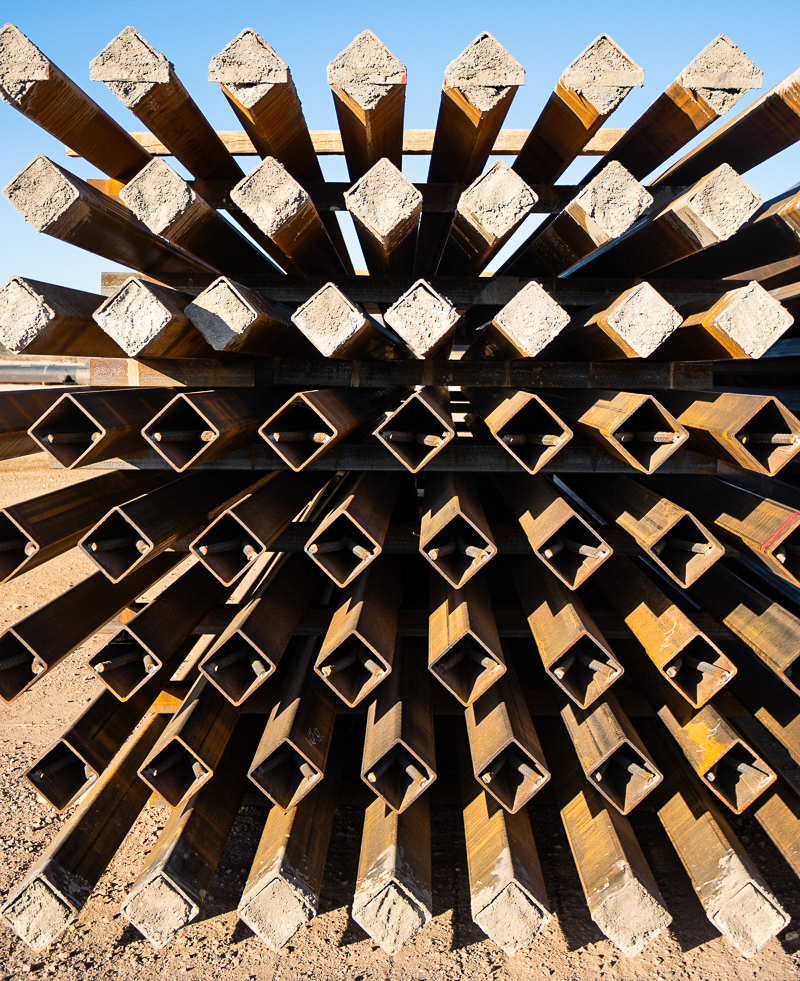 SAN BERNARDINO NATIONAL WILDLIFE REFUGE, ARIZONA – Some of the steel bollard fence posts were already filled with cement before being temporarily abandoned as the fence building was put on hold. MARCH 13, 2021 (Photo by Isaac Stone Simonelli/Cronkite Borderlands Project)
SAN BERNARDINO NATIONAL WILDLIFE REFUGE, ARIZONA – Some of the steel bollard fence posts were already filled with cement before being temporarily abandoned as the fence building was put on hold. MARCH 13, 2021 (Photo by Isaac Stone Simonelli/Cronkite Borderlands Project)
Morawe sought a compromise with Customs and Border Protection before the building began, in August 2019. He said the National Park Service had hoped the existing 15-foot-tall barrier built in 2008 along a stretch of 5.3 miles of Organ Pipe’s total of 30 miles of borderline would be raised by 3 feet, instead of doubling it to 30 feet. NPS also requested that lights not be installed because of their potential negative impact on wildlife.
Those requests were denied. On the ground, CBP used all the land legally available under the federal law to build the barrier.
“They took the full 60 feet. … They did everything,” Morawe said, referring to the so-called Roosevelt Reservation, a 60-foot swath of federal land that runs on the U.S. side of the border in California, Arizona and New Mexico and is reserved for border security purposes.
The project moved forward with the 30-foot wall, light system and a wide all-weather gravel road that took up the full width of the Roosevelt Reservation. The new 30-foot high barrier now runs the entire length of the Organ Pipe Cactus National Monument.
Morawe said the Park Service did get some concessions, such as where construction staging would take place.
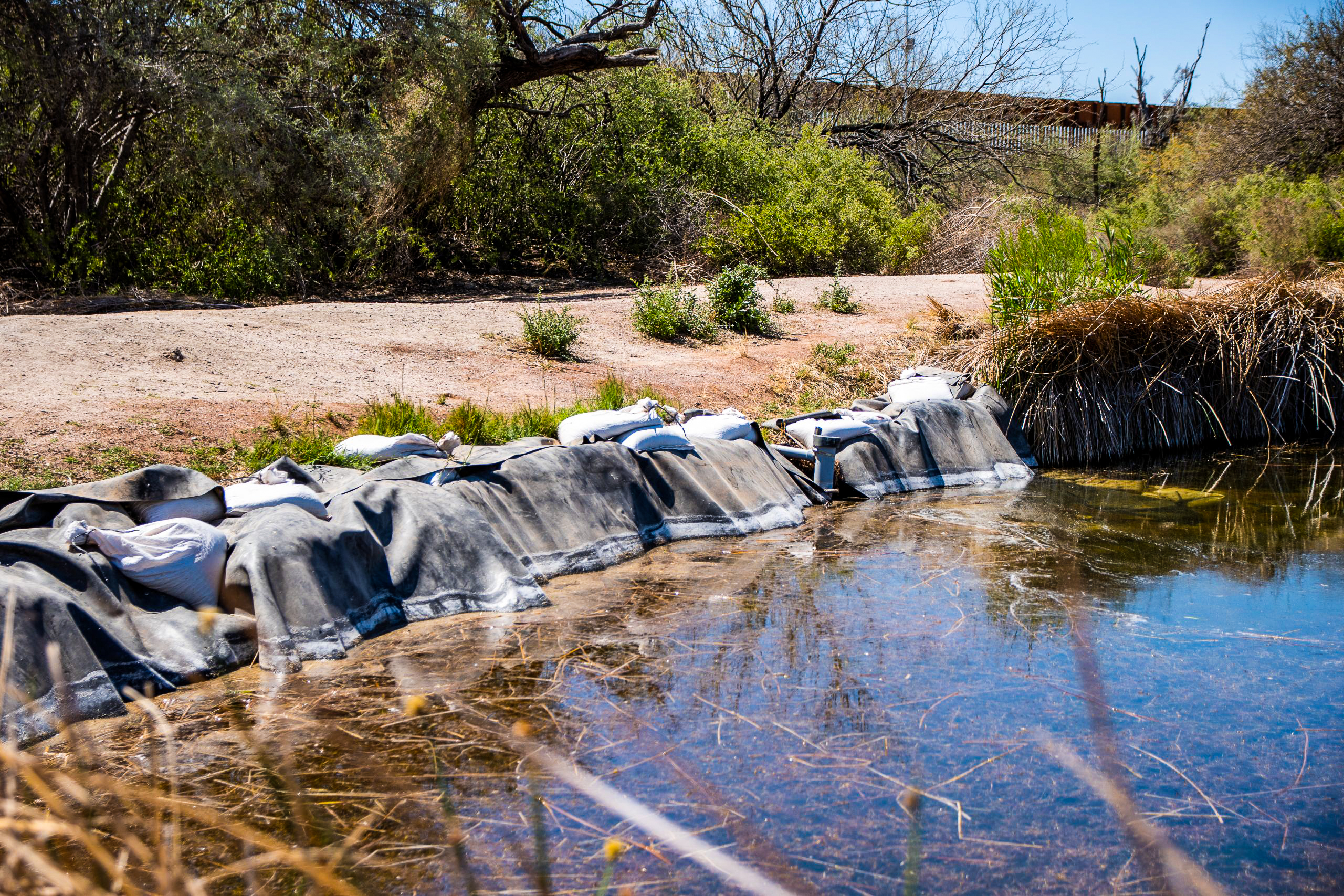 A rubber liner protects the southern edge of the pond below Quitobaquito Springs to shore up a crack in the man-made clay liner on March 28, 2021. (Photo by Isaac Stone Simonelli/Cronkite Borderlands Project)
A rubber liner protects the southern edge of the pond below Quitobaquito Springs to shore up a crack in the man-made clay liner on March 28, 2021. (Photo by Isaac Stone Simonelli/Cronkite Borderlands Project)
According to Customs and Border Protection, about 458 miles of “border wall system” were constructed during Trump’s tenure. Of the total, 373 miles were replacement barriers for some kind of previous fence or barrier. All-new construction totaled 85 miles.
Glenn-Kimbro, at her ranch about 200 miles east of Organ Pipe Cactus National Monument, voiced her frustration with construction of the border wall because of the impacts on the environment and its failure to secure the border.
“We’ve seen this huge change from the beginning when we were telling the United States government that there was this huge invasion of people,” Glenn-Kimbro said. “There was tons and tons of trash and hundreds of people, men, women, children from all sorts of countries.”
Glenn-Kimbro said she noticed a reduction in migrants crossing her land when vehicle barriers were put in place in 2007 and 2008.
She said the Border Patrol’s horse patrol continues to be an effective method of securing the border, but the wall itself – especially in its current condition – is not.
“They could have eliminated putting up the wall and just have surveillance,” Glenn-Kimbro said.
 SAN BERNARDINO NATIONAL WILDLIFE REFUGE, ARIZONA – Floodgates are built into the bollard fence to help manage flash floods. MARCH 13, 2021 (Photo by Isaac Stone Simonelli/Cronkite Borderlands Project)
SAN BERNARDINO NATIONAL WILDLIFE REFUGE, ARIZONA – Floodgates are built into the bollard fence to help manage flash floods. MARCH 13, 2021 (Photo by Isaac Stone Simonelli/Cronkite Borderlands Project)
About 10 years ago, the Border Patrol built towers on her ranch that were effective and had a relatively small environmental footprint, she said.
Glenn-Kimbro said she was especially frustrated by the new blasting and road-building that took place in the Peloncillo Mountains, which are at the northern tip of the home range of the
North American jaguar, an animal that’s on the U.S. Fish and Wildlife Service’s endangered species list and whose numbers in the United States have dwindled to the single digits.
“It wasn’t accessible, that’s why they had to blast,” Glenn-Kimbro said.
By blasting and road building, she said, the government has made the area more accessible to those illegally crossing the border, actually reducing border security.
“They need to fix what they messed up,” Glenn-Kimbro said.
To her, this includes restoring the natural landscape, establishing erosion prevention measures and restoring grasslands.
“Of course, wildlife and the environment is the last priority,” Glenn-Kimbro said. “And it shouldn’t be, because that’s a renewable resource.”
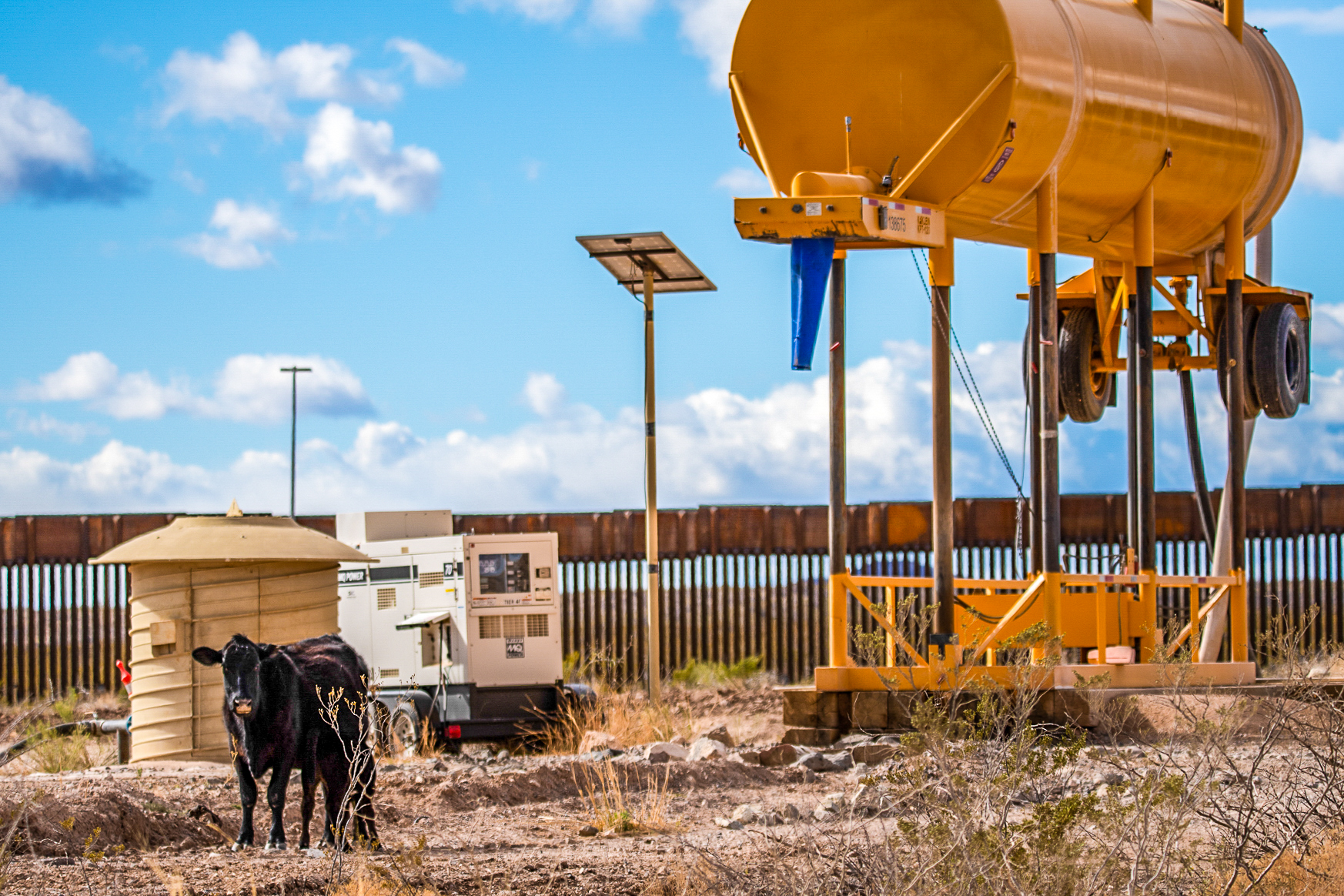 SAN BERNARDINO NATIONAL WILDLIFE REFUGE, ARIZONA – Cattle wander past a well used by contractors to mix the cement necessary for building the border fence on March 13, 2021. (Photo by Isaac Stone Simonelli/Cronkite Borderlands Project)
SAN BERNARDINO NATIONAL WILDLIFE REFUGE, ARIZONA – Cattle wander past a well used by contractors to mix the cement necessary for building the border fence on March 13, 2021. (Photo by Isaac Stone Simonelli/Cronkite Borderlands Project)
Glenn-Kimbro became directly involved in the debate over wall construction when concerns were raised about the effects on the San Bernardino National Wildlife Refuge east of Douglas, not far from her ranch. The wetlands are an important habitat for several types of wildlife, including five endangered species of fish.
Concerns hit a fever pitch last December when emails from refuge manager Bill Radke were made public through a Freedom of Information Act request by the
Center for Biological Diversity, based in Tucson.
In the emails, Radke, who has managed the refuge for two decades, explained how his staff was scrambling to minimize the harm to endangered species reliant on the manmade ponds at San Bernardino.
“Ongoing border infrastructure construction is utilizing large volumes of groundwater from the San Bernardino Valley, and that water withdrawal is already impacting many refuge wells, ponds, and other wetlands,” Radke wrote in a Dec. 11 email to staff members. “In an effort to initiate ‘life support’ actions, refuge staff have salvaged fish and allowed three refuge ponds to go dry.”
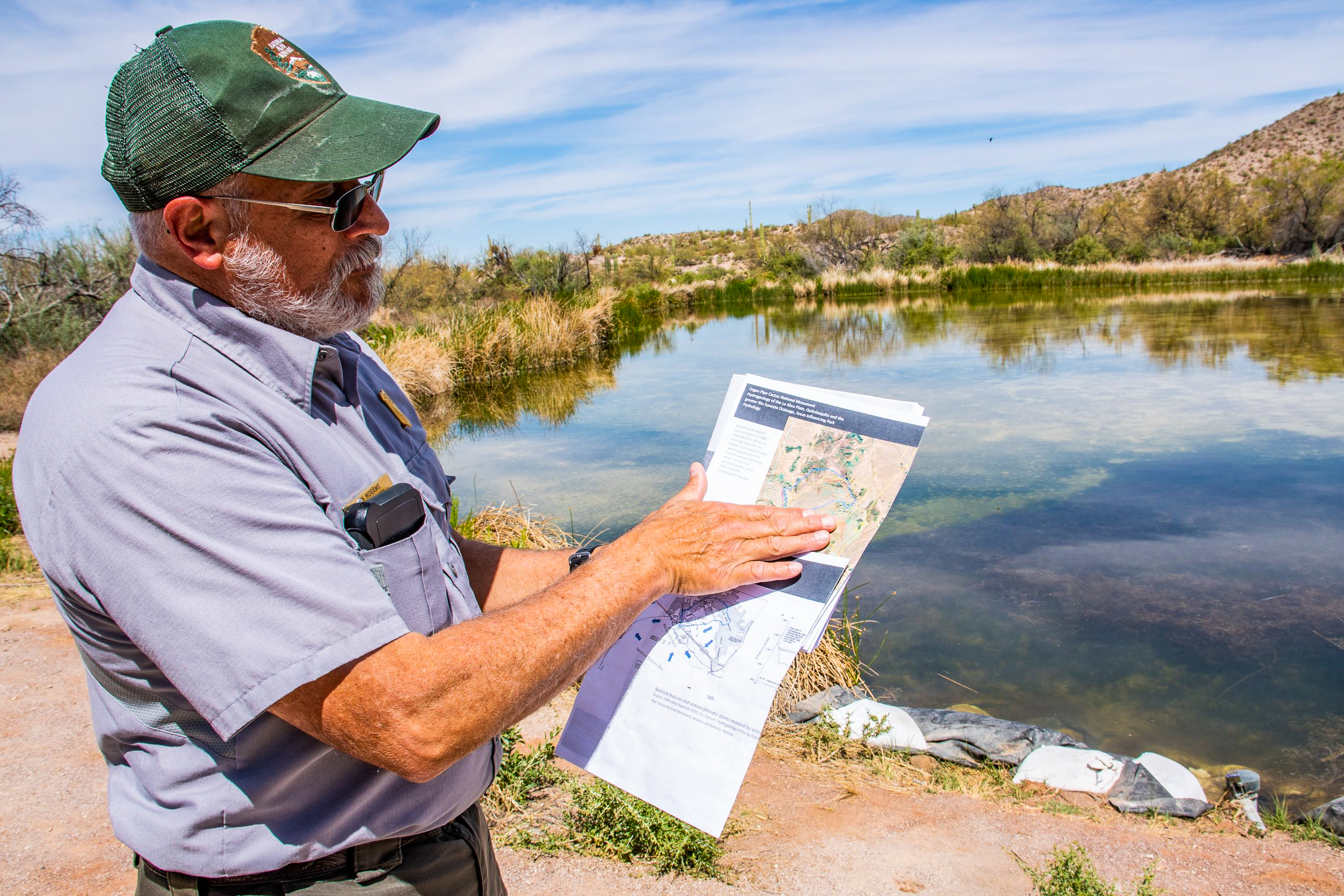 Rijk Morawe, the chief of natural and cultural resources management at Organ Pipe Cactus National Monument, displays a USGS study of the hydrogeology of the Quitobaquito Springs and La Abra Plain area on March 28, 2021. The wells tapped for border wall construction are outside the spring’s recharge area, he says, and are not the reason flow rates are down. (Photo by Isaac Stone Simonelli/Cronkite Borderlands Project)
Rijk Morawe, the chief of natural and cultural resources management at Organ Pipe Cactus National Monument, displays a USGS study of the hydrogeology of the Quitobaquito Springs and La Abra Plain area on March 28, 2021. The wells tapped for border wall construction are outside the spring’s recharge area, he says, and are not the reason flow rates are down. (Photo by Isaac Stone Simonelli/Cronkite Borderlands Project)
Radke appeared particularly concerned about water being extracted by contractors from the nearby Glenn Well, owned by Glenn-Kimbro, who had a federal contract for $1.50 per 1,000 gallons of water pumped from the well.
Radke wrote that he feared there would be a detrimental impact on groundwater levels by an estimated extraction of 700,000 gallons of water per day at a proposed cement plant developed on the Glenn Ranch for wall construction.
In a reply to Radke, Glenn-Kimbro wrote that she was trying to stop, stall or alter the contract.
“You know the environmental trump card is not going to work” with federal officials, Glenn-Kimbro wrote. “I am now trying the practicality and liability angle.”
Cronkite Borderlands Project is a multimedia reporting program in which students cover human rights, immigration and border issues in the U.S. and abroad in both English and Spanish.
The rancher later noted that the government was using eminent domain in Texas to secure resources needed for the barrier. Rather than fight the federal government, Glenn-Kimbro said, she leased the land on her ranch that contractors needed to build the fence, as well as provide water and gravel for the project.
“When they were mandated to build that wall, they were going to use gravel and dirt and water. Period,” Glenn-Kimbro said.
She said income from the deal has been a godsend for her ranch, which had to operate at reduced capacity during construction.
“The money we got for the rent is the way we were financially able to stay in business, because we had to reduce our cattle numbers, we could only use half of our ranch for a year and a half,” she said.
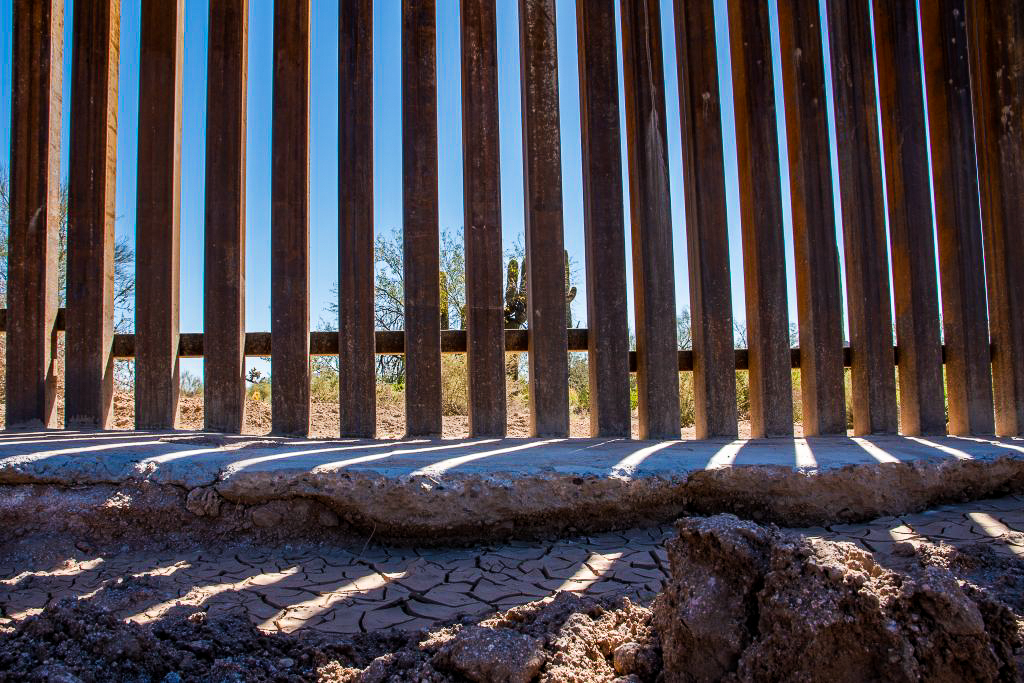 Erosion is evident along the border wall and all-season access road in Organ Pipe Cactus National Monument on March 28, 2021. (Photo by Isaac Stone Simonelli/Cronkite Borderlands Project)
Erosion is evident along the border wall and all-season access road in Organ Pipe Cactus National Monument on March 28, 2021. (Photo by Isaac Stone Simonelli/Cronkite Borderlands Project)
The Fish and Wildlife Service declined to make Radke available for an interview for this story. However, the agency said in a statement that the fears he voiced in his emails to staff had not come to fruition.
“San Bernardino National Wildlife Refuge ponds remain intact, and the refuge continues to manage for endangered fish and wildlife,” Beth Ullenberg, an external affairs officer for the service, wrote in an email response to questions. “Customs and Border Protection conducts some analysis and studies to minimize the impact of border security to species and habitats.”
Although Morawe and Glenn-Kimbro are mostly resigned to the wall’s imposing presence, a coalition of anti-wall activists, including Defenders of Wildlife and the Center for Biological Diversity, are asking the Biden administration to remove more than 55 miles of barrier built under Trump in Arizona.
At the end of February, the coalition called on the administration to take five steps to mitigate and remediate the damage done to the environment and cultural sites during barrier construction. These included cancelling construction contracts and diverting the funds to other purposes, “including removing harmful wall sections and mitigating damage caused by the wall.”

SAN BERNARDINO NATIONAL WILDLIFE REFUGE, ARIZONA – A vermilion flycatcher perches near a pond in the wildlife refuge on March 13, 2021. (Photo by Isaac Stone Simonelli/Cronkite Borderlands Project)
The letter also asks that the Biden administration “take immediate action to restore fragile and ecologically sensitive areas that have been harmed by wall construction” and “remove wall segments that harm or threaten to harm people, communities, wildlife and/or the land, and remediate damages.”
“At a minimum, we have to take down sections of wall where they’re blocking wildlife migration,” said Laiken Jordahl, a borderlands campaigner with the Center for Biological Diversity. “We have to work to revegetate all of the habitat that’s been bulldozed by Border Patrol.”
Of the approximately 55 miles of barrier identified by the group, 7 are in the Organ Pipe Cactus National Monument and 4.3 are along the San Bernardino National Wildlife Refuge, near Glenn Ranch.
Although Biden so far has delivered on his promise that there would not be “another foot of wall constructed,” there is no clarity on what the administration’s plans are moving forward.
“That’s been encouraging in some respects, but definitely can’t hold our breath just yet,” Jordahl said. “There’s a lot, a lot more we got to do to actually make sure they don’t start building again.”
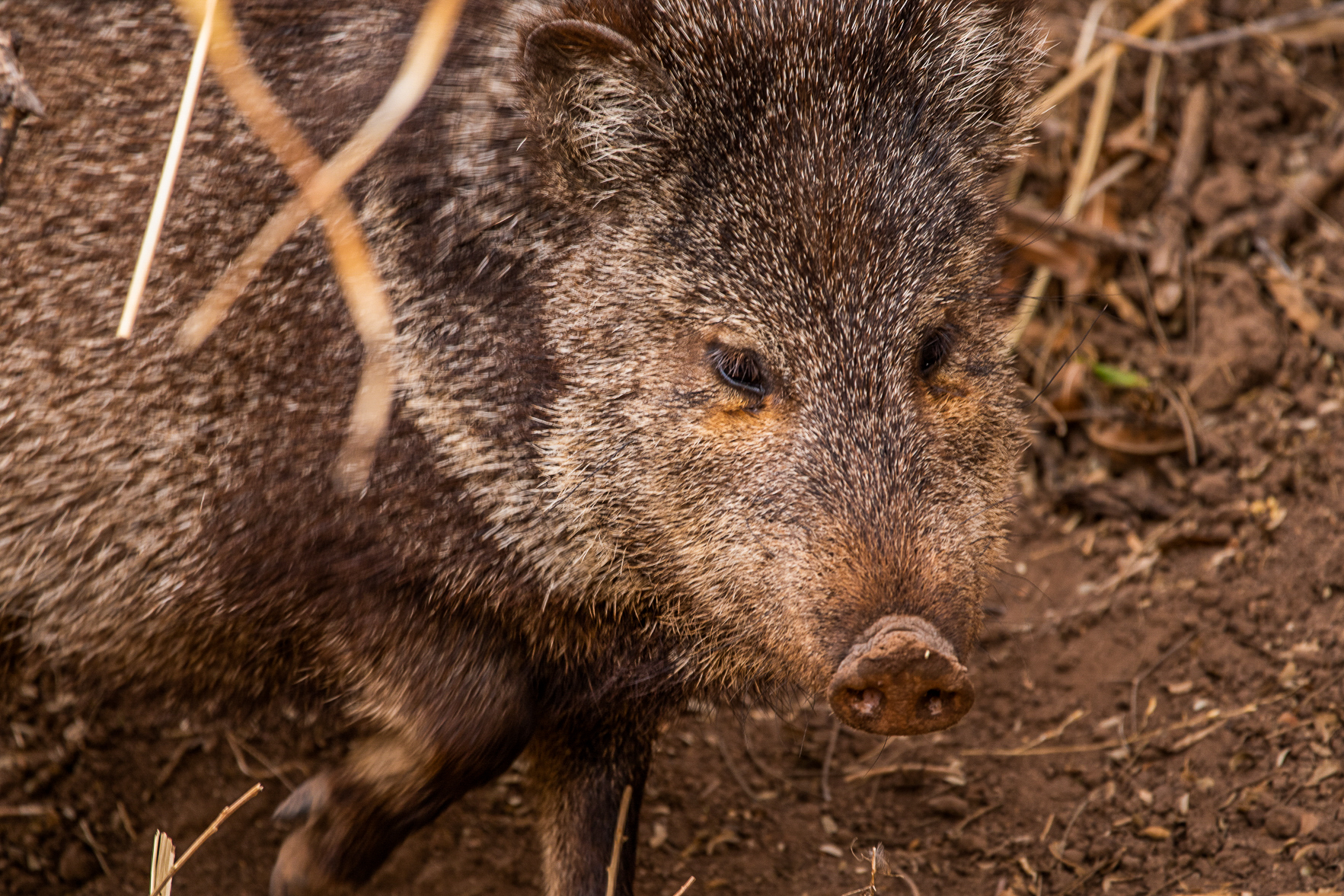 SAN BERNARDINO NATIONAL WILDLIFE REFUGE, ARIZONA – A herd of javelina gather in the national wildlife refuge on March 13, 2021. (Photo by Isaac Stone Simonelli/Cronkite Borderlands Project)
SAN BERNARDINO NATIONAL WILDLIFE REFUGE, ARIZONA – A herd of javelina gather in the national wildlife refuge on March 13, 2021. (Photo by Isaac Stone Simonelli/Cronkite Borderlands Project)
In early May, the government began filling in gaps in levees in the Rio Grande Valley in Texas that were excavated to build barriers. Levees will be shored up multiple places along a 13.4-mile stretch where construction was not completed. Filling in more gaps in the wall are not included in the construction project.
Some of the primary concerns environmental advocates have about border barriers are that they block wildlife corridors, divide wildlife territories and limit access to vital water resources in Mexico. Removal of native vegetation is a particular concern.
“That bulldozing destroys the vegetation and makes it very unlikely for wildlife to go out into those exposed areas, thereby blocking wildlife from crossing the border, even small wildlife that can fit in between the posts,” said Dan Millis, the Sierra Club Grand Canyon Chapter Borderlands program manager.
One big question Morawe has is how the contiguous wall along the national monument will affect wildlife that relied on water and food sources in Mexico.
“Unfortunately, our animals aren’t getting water,” he said.
 An endangered male Quitobaquito pupfish, also known as the Sonoyta pupfish, still has the blue stripe from mating season as it defends its territory in Quitobaquito Spring on March 28, 2021. (Photo by Isaac Stone Simonelli/Cronkite Borderlands Project)
An endangered male Quitobaquito pupfish, also known as the Sonoyta pupfish, still has the blue stripe from mating season as it defends its territory in Quitobaquito Spring on March 28, 2021. (Photo by Isaac Stone Simonelli/Cronkite Borderlands Project)
The National Park Service already has put some water tubs out for wildlife within the park and is working with the Arizona Game & Fish Department to develop water stations featuring 1,200-gallon tanks with troughs.
“That’s not something we normally do,” Morawe said. “But we don’t normally see a 28.5 mile solid fence in a national park, either.”
Morawe also is concerned about erosion, light pollution, impacts on natural water flow and the current flood mitigation measures.
Erosion already is occurring along some sections of the all-season road that haven’t been reinforced with larger rocks and concrete, which is one reason Morawe wants contractors to resume their work.
 An endangered Sonoyta mud turtle comes up for air in the pond below Quitobaquito Spring on March 28, 2021. (Photo by Isaac Stone Simonelli/Cronkite Borderlands Project)
An endangered Sonoyta mud turtle comes up for air in the pond below Quitobaquito Spring on March 28, 2021. (Photo by Isaac Stone Simonelli/Cronkite Borderlands Project)
In the bright light of a Monday morning in mid-April, Morawe pointed to a sump in the road where scarce spring rains had puddled. It’s possible to create an all-weather road without affecting the natural sheet flow of water across the landscape, he said, noting that there are examples of it within Organ Pipe Cactus National Monument. However, those designs were not used for the border barrier.
Maintaining sheet flow of water prevents flooding issues, including debris buildup against the bollards, Morawe said. However, a raised road like this one corrals this thin, uniform flow of water into unstable channels and ponds.
Water backed up by the road has moved beyond the cleared boundaries of the Roosevelt Reservation into National Park land, causing destruction.
“Some of the cacti are inundated,” Morawe said. “And, of course, they’re going to die – they can’t handle that kind of water.”
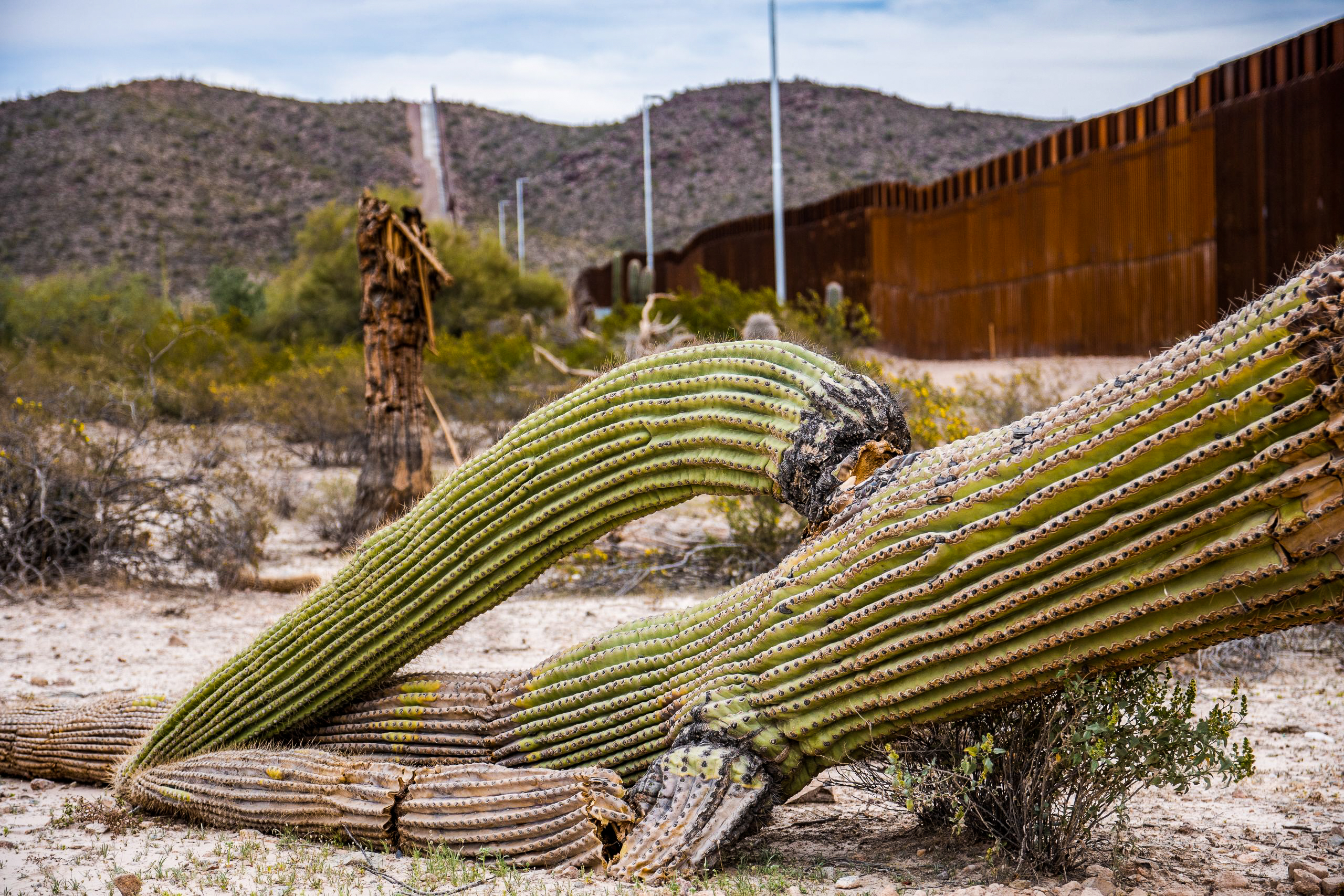 Despite efforts to save desert plants that were removed during the construction of the wall, not all those transplanted survived. Saguaro cactus, such as the one pictured, don’t usually start growing arms until they are at least 100 years old. (Photo by Isaac Stone Simonelli/Cronkite Borderlands Project)
Despite efforts to save desert plants that were removed during the construction of the wall, not all those transplanted survived. Saguaro cactus, such as the one pictured, don’t usually start growing arms until they are at least 100 years old. (Photo by Isaac Stone Simonelli/Cronkite Borderlands Project)
To the east, a more than 100-year-old saguaro that had been replanted lay broken and rotting because of water inundation.
Saguaros, which are protected in Arizona, also are considered sacred by the Tohono O’odham, who have for more than 1,000 years visited
Quitobaquito Springs in what now is the national monument.
“For us, we actually believe that saguaros are our ancestors that kind of, like, stand and protect us, they watch over us,” said Lourdes Pereira, a member of the Hia C-ed O’odham Alliance and Miss Indigenous Arizona State University.
Lorraine Eiler, first vice president of the Hia C-ed O’odham Alliance and member of the Tohono O’odham Legislative Council, said the impact to her homeland caused by contractors clearing land for the wall has been devastating.
“They have completely reorganized the topography of the land,” Eiler said. “I am waiting – other people are waiting – for the first big rainstorm that we get.”
Desert storms, which can dump enormous amounts of water onto the parched desert in minutes, create torrents that sweep cactuses and other vegetation south into Mexico, she said. Time and again, she has seen structures designed by engineers who don’t fully understand the true nature of the desert terrain.
Sue Rutman, a botanist at Organ Pipe Cactus National Monument who retired in 2013, saw similar issues when she was reviewing plans for the 15- to 18-foot tall mesh pedestrian fence erected in 2008 under the Obama administration.
A flood caused by monsoon rains that summer shoved debris against the mesh, backing up water to 7 feet deep, threatening to significantly change the riparian systems and flood flows, Rutman said. In July 2008, flash floods took the fence down completely.
“There was one place where the flood just hit that wall and twisted steel out – and just blew the fence out,” Rutman said.
In response, gates were added to areas prone to cross-border flash floods. But to prevent border crossers from entering the monument through the floodgates, some gates were welded shut, Rutman said, the idea being that someone would cut them open ahead of any flooding.
“Their ignorance and their entrenched resistance to us telling them anything was so strong that they just kept doing really stupid things,” she said. “It appears to me that there were no lessons learned.”
Morawe, like many conservationists, is concerned about how the barrier will affect desert floods.
He points to seasonal flooding in areas where no floodgates were installed and questions the effectiveness of those that are in place. Once the border barrier is handed over from the U.S. Army Corps of Engineers, the agency overseeing construction, to Border Patrol, Morawe hopes there will be changes in operations to allow agents to at least effectively manage the floodgates.
“I think they’re banking on the fact that the bollard fence is going to allow more water through, which is true. It will,” he said. “But you’re still going to get debris slamming up against that fence and eventually pooling up water.”
“When you look at this, some of these people that design this have never seen a 2,000-pound saguaro floating like a toothpick, you know, under a flood event and smacking up against their fence.
“Maybe it’ll be fine. Maybe it won’t. We’ll see.”
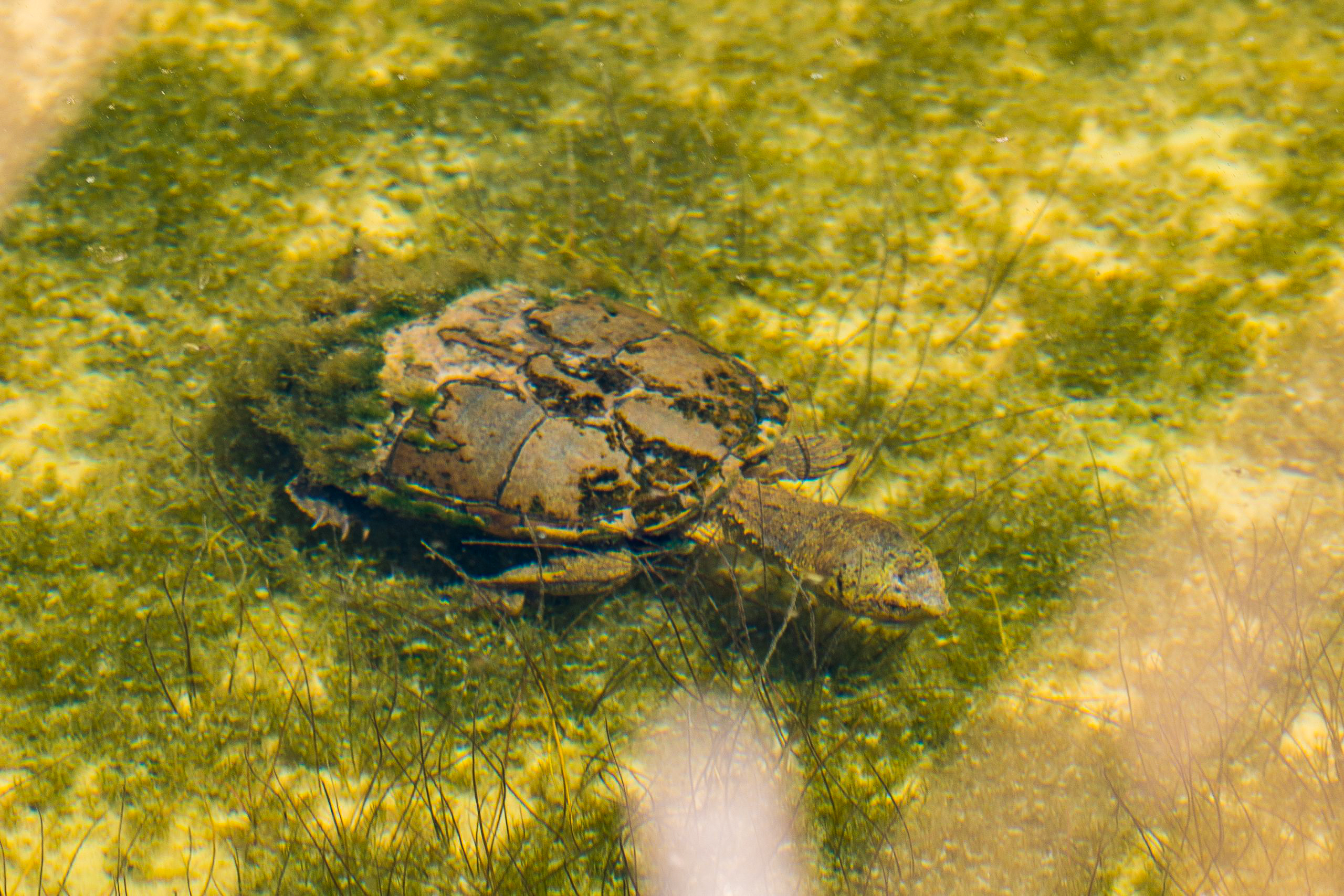 An endangered Sonoyta mud turtle swims along the bottom of the pond below the sacred Quitobaquito Spring. “If we didn’t have this habitat, the species would cease to exist,” explains Rijk Morawe, the chief of natural and cultural resources management at Organ Pipe Cactus National Monument. (Photo by Isaac Stone Simonelli/Cronkite Borderlands Project)
An endangered Sonoyta mud turtle swims along the bottom of the pond below the sacred Quitobaquito Spring. “If we didn’t have this habitat, the species would cease to exist,” explains Rijk Morawe, the chief of natural and cultural resources management at Organ Pipe Cactus National Monument. (Photo by Isaac Stone Simonelli/Cronkite Borderlands Project)
In addition to infrastructure issues, ongoing environmental management has emerged as a concern in barrier construction zones.
The Trump administration bypassed regular environmental reviews before building. The administration issued waivers connected to the border wall construction under the REAL ID Act of 2005.
According to the Center for Biological Diversity, this led to
bypassing 32 laws in Arizona, including the Endangered Species Act, the Federal Water Pollution Control Act, the Safe Drinking Water Act, the National Environmental Policy Act, the Reclamation Project Act of 1939, the Fish and Wildlife Coordination Act and the Comprehensive Environmental Response, Compensation and Liability Act.
The REAL ID Act was created in the wake of 9/11 as a tool for the federal government to combat terrorism and crime. However, it also provided significant power to the secretary of Homeland Security, who was given “the authority to waive all legal requirements … necessary to ensure expeditious construction” of a southern border wall.
There is precedent for the Trump administration’s use of the REAL ID Act for border wall construction. It was cited four times by Michael Chertoff, secretary of Homeland Security under George W. Bush, for construction on the southern border.
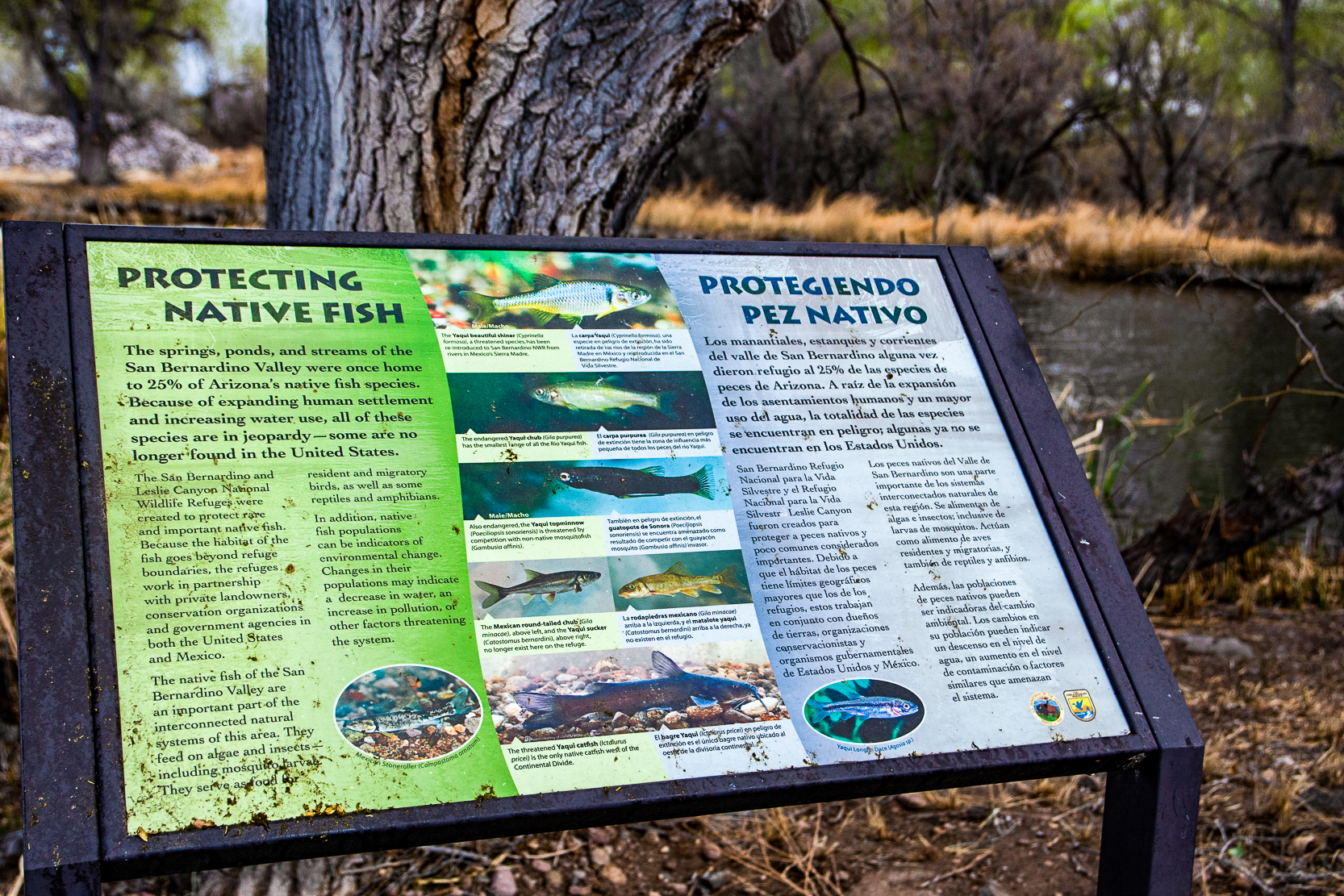 SAN BERNARDINO NATIONAL WILDLIFE REFUGE, ARIZONA – The wetlands of the San Bernardino National Wildlife Refuge is an important habitat for various types of wildlife, including five endangered species of fish. MARCH 13, 2021 (Photo by Isaac Stone Simonelli/Cronkite Borderlands Project)
SAN BERNARDINO NATIONAL WILDLIFE REFUGE, ARIZONA – The wetlands of the San Bernardino National Wildlife Refuge is an important habitat for various types of wildlife, including five endangered species of fish. MARCH 13, 2021 (Photo by Isaac Stone Simonelli/Cronkite Borderlands Project)
Despite these environmental protections being waived, Rob Daniels, a public affairs specialist for Customs and Border Protection in Arizona, said in an email that the agency “is committed to responsible environmental stewardship and engages in environmental planning for all construction projects – including the construction of border barriers.”
Environmentalists are skeptical.
Rutman, the retired Organ Pipe botanist, recalls early interactions with Border Patrol as it stepped up efforts in the mid-1990s to slow a sudden flood of undocumented migrants crossing the border into the monument.
“Pretty early on, we still thought we could influence what the Border Patrol did,” she said. “But that turned out to be false. Park Service had almost no influence on what the Border Patrol did or didn’t do.”
Despite a 2006 agreement that the Border Patrol would document and report off-road usage by agents to the National Park Service, wildlife cams showed that Border Patrol agents were only reporting a fraction of the times they left the roads.
Morawe tried to be optimistic about the possibilities of the barrier protecting wildlands, assuming contractors are allowed to return to work and start mitigating potential issues.
“Let’s make sure it’s as functional as it can be, so that Border Patrol can use it like it’s intended to be used,” he said.
Securing the border along Organ Pipe Cactus National Monument has been no easy feat. Before vehicle barriers were set up in 2006, Morawe said, people simply drove off of Mexico’s Federal Highway 2, a few hundred yards from the park’s border, and headed north into the desert until their cars broke down. They then continued by foot.
“We hauled out large numbers of vehicles just trying to get them out of the wilderness,” Morawe said.
If Border Patrol is able to effectively use the wall to prevent undocumented immigrants from crossing into the park, apprehending them before they leave the Roosevelt Reservation, he said, it would mitigate the damages done by Border Patrol agents chasing people deep into protected wilderness areas.
“I always wish there was a better way of doing things than having a fence,” Morawe said. “But we have it now. We have to deal with it. And that’s going to be our new reality going forward.”
What that reality will look like is hard to say, however.
“We’re figuring this out day-by-day,” Morawe said. “We don’t know.”
For more stories from Cronkite News, visit cronkitenews.azpbs.org.
Note: This story originally appeared on Cronkite News. It is published via a Creative Commons license. Cronkite News is produced by the Walter Cronkite School of Journalism and Mass Communication at Arizona State University.

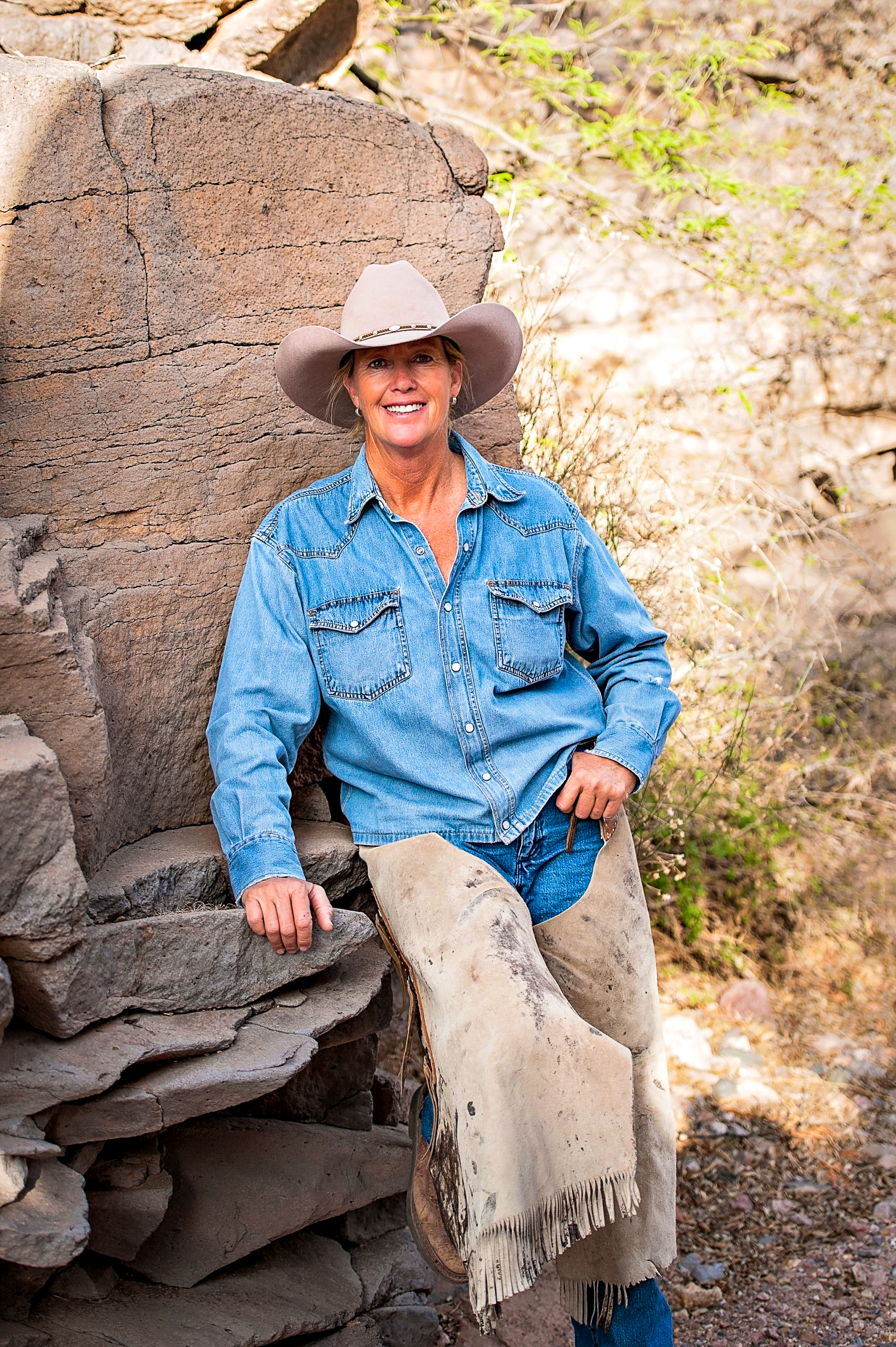














 SAN BERNARDINO NATIONAL WILDLIFE REFUGE, ARIZONA – The wetlands of the San Bernardino National Wildlife Refuge is an important habitat for various types of wildlife, including five endangered species of fish. MARCH 13, 2021 (Photo by Isaac Stone Simonelli/Cronkite Borderlands Project)
SAN BERNARDINO NATIONAL WILDLIFE REFUGE, ARIZONA – The wetlands of the San Bernardino National Wildlife Refuge is an important habitat for various types of wildlife, including five endangered species of fish. MARCH 13, 2021 (Photo by Isaac Stone Simonelli/Cronkite Borderlands Project)